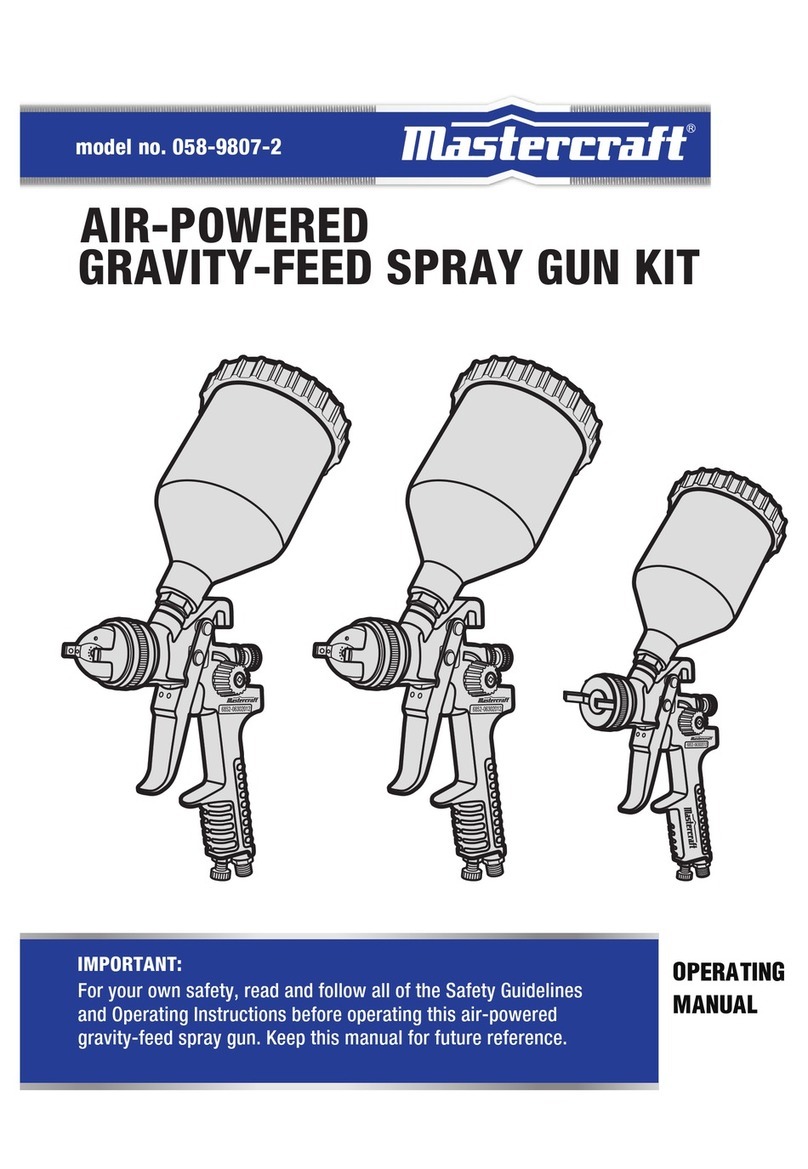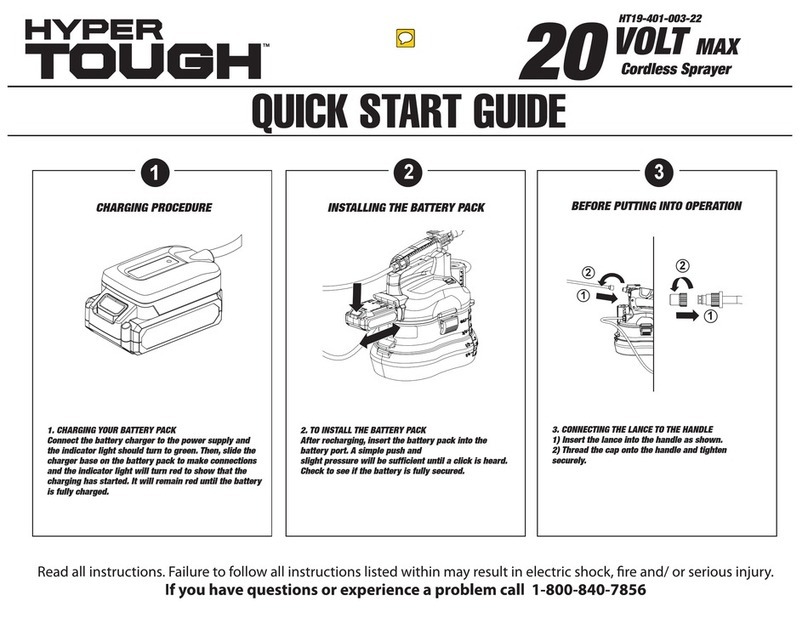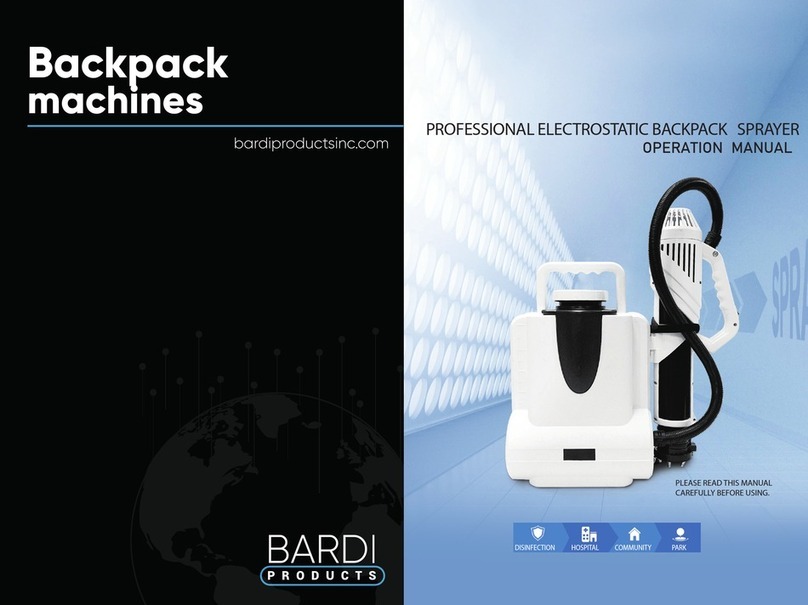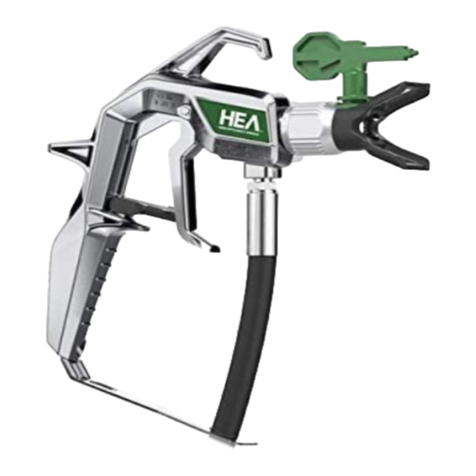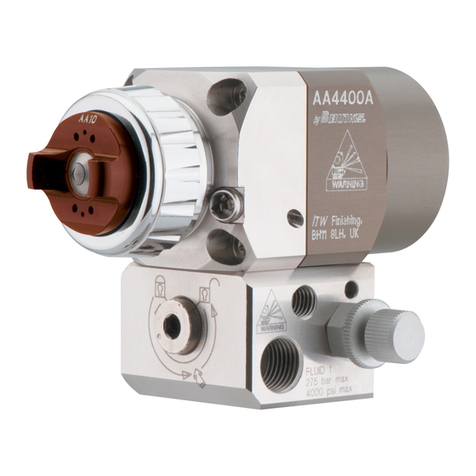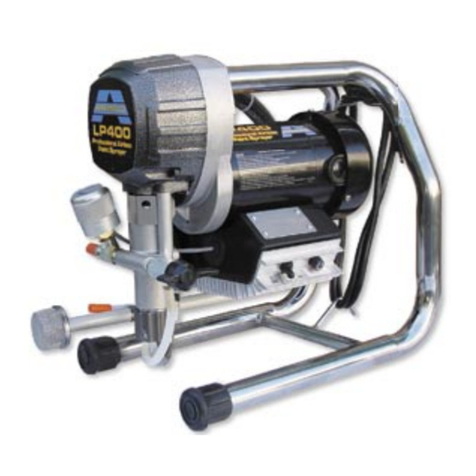Dino-Power DP-6336iB User manual

Operating Instruction
Model Number:
DP-6336iB, DP-6337iB
With Electronical Pressure Control, Brushless Motor
Please read and keep this manual, Read carefully before attempting to assemble, install, operate or maintain the
product described. Protect yourself and others by observing all safety information. Failure to comply with instructions
could result in personal injury and/or property damage! Retain instruction for future reference.
www.dpairless.com www.dino-power.com www.airlesspaintsprayer-pump.com
1

Table of Contents
Safety Precautions .................................................2
General Description ...............................................3
Operation ................................................................4
Setup ....................................................................4
Preparing to Paint .................................................5
Painting .................................................................5
Pressure Relief Procedure ....................................6
Spraying ..................................................................6
Spraying Technique ..............................................6
Practice .................................................................7
Cleanup ...................................................................8
Cleaning the Spray Tip .........................................8
Maintenance............................................................8
General Repair and Service Notes........................8
Replacing the Motor Assembly .............................9
Replacing the Gears .............................................9
Replacing the Transducer......................................10
Replacing the PRIME/SPRAY Valve......................10
Servicing the Fluid Section ...................................10
Replacing the Filters .............................................11
Parts Listings..........................................................14
Fluid Section Assembly ........................................14
Troubleshooting .....................................................16
Safety Precautions
This manual contains information that must be read
and understood before using the equipment. When you
come to an area that has one of the following symbols,
pay particular attention and make certain to heed the
safeguard.
This symbol indicates a potential hazard that may
cause serious injury or loss of life. Important safety
information will follow.
This symbol indicates a potential hazard to you or to
the equipment. Important information that tells how to
prevent damage to the equipment or how to avoid
causes of minor injuries will follow.
NOTE: Notes give important information which
should be given special attention.
Prevention:
NEVER aim the gun at any part of the body
NEVER allow any part of the body to touch the fluid
stream.
DO NOT allow body to touch a leak in the fluid hose.
NEVER put hand in front of the gun. Gloves will not
provide protection against an injection injury.
ALWAYS lock gun trigger, shut pump off, and release
all pressure before servicing, cleaning tip or guard,
changing tip, or leaving unattended. Pressure will not
be released by turning off the motor. The PRIME/
SPRAY valve handle must be turned to PRIME to
relieve the pressure. Refer to the PRESSURE RELIEF
PRESSURE described in the pump manual.
ALWAYS keep tip guard in place while spraying. The
tip guard provides some protection but is mainly a
warning device.
ALWAYS remove the spray tip before flushing or
cleaning the system. Paint hose can develop leaks
from wear, kinking and abuse. Leak can inject material
into the skin. Inspect the hose before each use.
NEVER use a spray gun without a working trigger lock
and trigger guard in place.
All accessories must be rated at or above 3200
PSI/221 BAR. This includes spray tips, guns,
extensions, and hose.
NOTE TO PHYSICIAN:
Injection into the skin is a traumatic injury. It is
important to treat the injury as soon as possible. DO
NOT delay treatment to research toxicity. Toxicity is a
concern with some coatings injected directly into the
blood stream. Consultation with a plastic surgeon or
reconstructive hand surgeon may be advisable.
HAZARD: EXPLOSION ANDFIRE - Solvent and paint
fumes can explode or ignite. Severe injury and/or
property damage can occur.
PREVENTION:
1. Provide extensive exhaust and fresh air introduction
to keep the air within the spray area free from
accumulation of flammable vapors.
2

2. Avoid all ignition sources such as static electricity
sparks, electrical appliances, flames, pilot lights, hot
objects, and sparks from connecting and disconnecting
power cords
3.Do not smoke in spray area.
4.Fire extinguisher must be present and in good
working order.
5.Place pump at least 20 feet (6.1 m) from the spray
object in a well ventilated area (add more hose if
necessary). Flammable vapors are often heavier than
air. Floor area must be extremely well ventilated.
The pump contains arcing parts that emit sparks and
can ignite vapors.
6. The equipment and objects in and around the spray
area must be properly grounded to prevent static
sparks.
7. Use only conductive or grounded high-pressure fluid
hose. Gun must be grounded through hose
connections.
8. Power cord must be connected to a grounded circuit.
Always flush unit into separate metal container, at low
pump pressure, with spray tip removed. Hold gun firmly
against side of container to ground container and
prevent static sparks.
9.Follow material and solvent manufacturer's
warnings and instructions.
10.Use extreme caution when using materials with a
Flashpoint below 70°F (21℃). Flashpoint is the
temperature at which a fluid can produce enough
vapors to ignite.
11. Plastic can cause static sparks. Never hang plastic
to enclose spray area. Do not use plastic drop cloths
when spraying flammable materials.
12. Use lowest possible pressure to flush equipment.
Earthing Instructions
This product must be grounded. In the event of an
electrical short circuit, grounding reduces the risk of
electric shock by providing an escape wire for the
electric current. This product is equipped with a cord
having a grounding wire with an appropriate grounding
plug. The plug must be plugged into an outlet that is
properly installed and grounded in accordance with all
local codes and ordinances.
DANGER---Improper installation of the grounding plug
can result in a risk of electric shock. If repair or
replacement of the cord or plug is necessary, do not
connect the green grounding wire to either flat blade
terminal. The wire with insulation having a green outer
surface with or without yellow stripes is
the grounding wire and must be connected to the
grounding pin.
Check with a qualified electrician or serviceman if the
grounding instructions are not completely understood,
or if you are in doubt as to whether the product is
properly grounded. Do not modify the plug provided.
If the plug will not fit the outlet, have the proper outlet
installed by a qualified electrician.
General Description
This airless sprayer is a precision power tool used for
spraying many types of materials. Read and follow
this instruction manual carefully for proper operating
instructions, maintenance, and safety information.
Pressure control Knob
Motor
Plug
Chrome Coated Trolly Cart
Outlet fitting
S.S. fluid pump
Digital Display
ON/OFF Switch
3

Operation
This equipment produces a fluid stream at extremely
high pressure. Read and understand the warnings in
the Safety Precautions section at the front of this
manual before operating this equipment.
Setup
Perform the following procedure before plugging in the
power cord of an electric unit.
1.Ensure that the suction set and the return hose are
attached and secure.
2.Using a wrench, attach a minimum of 50’ of 1/4”
nylon airless spray hose to the unit. Tighten securely.
3.Attach an airless spray gun to the spray hose.
Using two wrenches (one on the gun and one on the
hose), tighten securely.
NOTE:Do not attach the tip to the spray gun yet. Remove the
tip if it is already attached.
Make sure all airless hoses and spray guns are
electrically grounded and rated for at least 3200 psi
(220 bar) fluid pressure.
4.Make sure the pressure control knob is in its OFF
position in the black zone.
5.Make sure the ON/OFF switch is in its OFF position.
6.Fill the oil cup with one tablespoon of piston seal
lubricant (Piston Lube).
Never operate unit for more than ten seconds without fluid.
Operating this unit without fluid will cause unnecessary wear
to the packings.
7.Make sure the electrical service is 220V/50HZ
8.Plug the power cord into a properly grounded outlet
at least 25’ from the spray area.
Always use a minimum 12 gauge, three-wire extension cord
with a grounded plug. Never remove the third prong or use an
adapter.
Preparing a New Sprayer
If this unit is new, it is shipped with test fluid in the fluid
section to prevent corrosion during shipment and
storage. This fluid must be thoroughly cleaned out of
the system with mineral spirits before you begin
spraying.
Always keep the trigger lock on the spray gun in
the locked position while preparing the system.
1.Place the suction tube into a container of mineral
spirits.
2.Place the return hose into a metal waste container.
3.Set the pressure to minimum by turning the pressure
control knob to the”Min” setting
(clockwise -- increased working pressure)
4.Move the PRIME/SPRAY valve down to the PRIME
Position.
5.Turn the unit on by moving the ON/OFF switch to the
ON position.
6.Allow the sprayer to run for 15-30 seconds to flush
the test fluid out through the return hose and into the
waste container.
7.Turn the unit off by moving the ON/OFF switch to the
OFF position.
4

Preparing to Paint
Before painting, it is important to make sure that the
fluid in the system is compatible with the paint that is
going to be used.
NOTE: Incompatible fluids and paint may cause the
valves to become stuck closed, which would
require disassembly and cleaning of the
Sprayer’s fluid section.
1.Place the suction tube into a container of the
appropriate solvent. Examples of the appropriate
solvent are water for latex paint or mineral spirits for
oil-based paints.
2.Place the return hose into a metal waste container.
3.Set the pressure to minimum by turning the pressure
control knob to the ”Min”
4.Move the PRIME/SPRAY valve down to the PRIME
position.
5.Turn the unit on by moving the ON/OFF switch to the
ON position.
6.Allow the sprayer to run for 15¨C30 seconds to flush
the old solvent out through the return hose and into the
metal waste container.
7.Turn the unit off by moving the ON/OFF switch to the
OFF position.
NOTE: Make sure that the spray gun does not have
a tip or tip guard installed.
8.Move the PRIME/SPRAY valve up to the SPRAY
position.
9.Turn the unit on.
10.Unlock the gun by turning the gun trigger lock to the
unlocked position.
Ground the gun by holding it against the edge of the
metal container while flushing. Failure to do so may
lead to a static electric discharge, which may cause
a fire.
11.Trigger the gun into the metal waste container until
the old solvent is gone and fresh solvent is coming out
of the gun.
12.Lock the gun by turning the gun trigger lock to the
locked position.
13. Set down the gun and increase the pressure by
turning the pressure control knob slowly clockwise.
14.Check the entire system for leaks. If leaks occur,
follow the”Pressure Relief Procedure” in this manual
before tightening any fittings or hoses.
15.Follow the “Pressure Relief Procedure”in this
manual before changing from solvent to paint.
Be sure to follow the pressure relief procedure when
shutting the unit down for any purpose, including
servicing or adjusting any part of the spray system,
changing or cleaning spray tips, or preparing for
cleanup.
Painting
1.Place the suction tube into a container of paint.
2.Place the return hose into a metal waste container.
3.Set the pressure to minimum by turning the pressure
control knob to the “Min” setting .
4.Move the PRIME/SPRAY valve down to the PRIME
position.
5.Turn the unit on by moving the ON/OFF switch to the
ON position.
6.Allow the sprayer to run until paint is coming through
the return hose into the metal waste container position.
8.Remove the return hose from the waste container
and place it in its operating position above the
container of paint.
9.Move the PRIME/SPRAY valve up to the SPRAY
position.
10.Turn the unit on.
5

11.Unlock the gun by turning the gun trigger lock to the
unlocked position.
(Ground the gun by holding it against the edge of the metal
container while flushing. Failure to do so may lead to a static
electric discharge, which may cause a fire.)
12.Trigger the gun into the metal waste container until
all air and solvent is flushed from the spray hose and
paint is flowing freely. rom the gun.
13.Lock the gun by turning the gun trigger lock to the
locked position.
14.Turn the unit off.
15.Attach tip guard and tip to the gun as instructed by
the tip guard or tip manuals.
POSSIBLE INJECTION HAZARD. Do not spray
without the tip guard in place. Never trigger the gun
unless the tip is in either the spray or the unclog
position. Always engage the gun trigger lock before
removing, replacing or cleaning tip.
16.Turn the unit on.
17.Increase the pressure by turning the pressure
control knob slowly clockwise toward the green zone
and test the spray pattern on a piece of cardboard.
Adjust the pressure control knob until the spray from
the gun is completely atomized. Try to keep the
pressure control knob at the lowest setting that
maintains good atomization.
NOTE:Turning the pressure up higher then needed to atomize
the paint will cause premature tip wear and additional
overspray.
Pressure Relief Procedure
Be sure to follow the pressure relief procedure when
shutting the unit down for any purpose, including
servicing or adjusting any part of the spray system,
changing or cleaning spray tips, or preparing for
cleanup.
1.Lock the gun by turning the gun trigger lock to the
locked position.
2.Turn the unit off by moving the ON/OFF switch to the
OFF position.
3.Turn the pressure control knob counter clockwise to
its OFF position
4.Unlock the gun by turning the gun trigger lock to the
unlocked position.
5.Hold the metal part of the gun firmly to the side of a
metal container to ground the gun and avoid a build up
of static electricity.
6.Trigger the gun to remove any pressure that may still
be in the hose.
7.Lock the gun by turning the gun trigger lock to the
locked position.
8.Move the PRIME/SPRAY valve down to the PRIME
position.Trigger lock in locked position.
Spraying
POSSIBLE INJECTION HAZARD. Do not spray without the
tip guard in place. Never trigger the gun unless the tip is in
either the spray or the unclog position. Always engage the
gun trigger lock before removing, replacing, or cleaning tip.
Spraying Technique
The following techniques, if followed, will assure
professional painting results.
Hold the gun perpendicular to the surface and always
at equal distance from the surface. Depending on the
type of material, surface, or desired spray pattern, the
gun should be held at a distance of 12 to 14 inches (30
to 35 cm).
Move the gun either across or up and down the surface
at a steady rate. Moving the gun at a consistent speed
conserves material and provides even coverage. The
correct spraying speed allows a full, wet coat of paint to
be applied without runs or sags.
Holding the gun closer to the surface deposits more
paint on the surface and produces a narrower spray
pattern. Holding the gun farther from the surface
produces a thinner coat and wider spray pattern. If
runs, sags, or excessive paint occur, change to a spray
tip with a smaller orifice. If there is an
insufficient amount of paint on the surface or you
desire to spray faster, a larger orifice tip should be
selected.
Maintain uniform spray stroke action. Spray alternately
from left to right and right to left. Begin movement of
the gun before the trigger is pulled.
6

Avoid arcing or holding the gun at an angle. This will
result in an uneven finish.
Proper lapping (overlap of spray pattern) is essential to
an even finish. Lap each stroke. If you are spraying
horizontally, aim at the bottom edge of the preceding
stroke, so as to lap the previous pattern by 50%.
For corners and edges, split the center of the spray
pattern on the corner or edge and spray vertically
so that both adjoining sections receive approximately
receive approximately even amounts of paint.
When spraying with a shield, hold it firmly against the
Angle the spray gun slightly away from the shield and
toward the surface. This will prevent paint from being
forced underneath.
Shrubs next to houses should be tied back and
covered with a canvas cloth. The cloth should be
removed as soon as possible. Titan gun extensions
are extremely helpful in these situations.
Nearby objects such as automobiles, outdoor furniture,
etc. should be moved or covered whenever in the
vicinity of a spray job. Be careful of any other
surrounding objects that could be damaged by
overspray.
Practice
1.Be sure that the paint hose is free of kinks and clear
of objects with sharp cutting edges.
2.Turn the pressure control knob counterclockwise to
its to its lowest setting.
3.Turn the PRIME/SPRAY valve up to its SPRAY
position.
4.Turn the pressure control knob clockwise to its
highest setting. The paint hose should stiffen as paint
begins to flow through it.
5.Unlock the gun trigger lock.
6.Trigger the spray gun to bleed air out of the hose.
7.When paint reaches the spray tip, spray a test area
to check the spray pattern.
8.Use the lowest pressure setting necessary to get a
good spray pattern. If the pressure is set too high, the
spray pattern will be too light. If the pressure is set too
low, tailing will appear or the paint will spatter out in
gobs rather than in a fine spray.
7

Cleanup
Special cleanup instructions for use with flammable
solvents:
always flush spray gun preferably outside and at least
one hose length from spray pump.
If collecting flushed solvents in a one gallon metal
container, place it into an empty five gallon container,
then flush solvents.
Area must be free of flammable vapors.
Follow all cleanup instructions.
The sprayer, hose, and gun should be cleaned
thoroughly after daily use. Failure to do so permits
material to build up, seriously affecting the
performance of the unit.
Always spray at minimum pressure with the gun nozzle
tip removed when using mineral spirits or any other
solvent to clean the sprayer, hose, or gun. Static
electricity buildup may result in a fire or explosion in the
presence of flammable vapors.
1.Follow the “Pressure Relief Procedure”found in the
Operation section of this manual.
2.Remove the gun tip and tip guard and clean with a
brush using the appropriate solvent.
3.Place the suction tube into a container of the
appropriate solvent. Examples of the appropriate
solvent are water for latex paint or mineral spirits for
oil-based paints.
4.Place the return hose into a metal waste container.
5.Move the PRIME/SPRAY valve down to its PRIME
position.
6.Set the pressure to Turbo Pulse Clean by
turning the pressure control knob to its CLEAN position
7.Turn the unit on by moving the ON/OFF switch to the
ON position.
8.Allow the solvent to circulate through the unit and flush
the paint out of the return hose into the metal waste
container.
9.Turn the unit off by moving the ON/OFF switch to the
OFF position.
10.Move the PRIME/SPRAY valve up to its SPRAY
position.
11.Turn the unit on.
Ground the gun by holding it against the edge of
the metal container while flushing. Failure to do
so may lead to a static electric discharge, which
may cause a fire.
12.Trigger the gun into the metal waste container until
the paint is flushed out of the hose and solvent is
coming out of the gun.
13.Continue to trigger the spray gun into the waste
container until the solvent coming out of the gun is
clean.
NOTE:For long-term or cold weather storage, pump
mineral sprits through the entire system. For short-term
storage when using latex paint, pump water mixed with Titan
Liquid Shield through the entire system (see the Accessories
section of this manual for part number).
14.Follow the ¡°Pressure Relief Procedure¡± found in
the Operation section of this manual.
15.Unplug the unit and store in a clean, dry area.
Do not store the unit under pressure.
Maintenance
Before proceeding, follow the Pressure Relief
Procedure outlined previously in this manual.
Additionally, follow all other warnings to reduce the risk
of an injection injury, injury from moving parts or
electric shock. Always unplug the sprayer before
servicing!
General Repair and Service Notes
The following tools are needed when repairing this
sprayer:
Phillips Screwdriver 3/8" Hex Wrench
Needle Nose Pliers 5/16" Hex Wrench
Adjustable Wrench 1/4" Hex Wrench
Rubber Mallet 3/16" Hex Wrench
Flat-blade Screwdriver 5/32” Hex Wrench
1.Before repairing any part of the sprayer, read the
instructions carefully, including all warnings.
8

CAUTION
Never pull on a wire to disconnect it. Pulling on a
wire could loosen the connector from the wire.
2.Test your repair before regular operation of the
sprayer to be sure that the problem is corrected. If the
sprayer does not operate properly, review the repair
procedure to determine if everything was done correctly.
Refer to the Troubleshooting Charts to help identify
other possible problems.
3.Make certain that the service area is well ventilated in
case solvents are used during cleaning. Always wear
protective eyewear while servicing. Additional
protective equipment may be required depending on the
type of cleaning solvent. Always contact the supplier
of solvents for recommendations.
Replacing the Motor
1.Unplug the unit.
2.Loosen and remove the four motor cover screws.
Remove the motor cover.
3.Disconnect the black and red wires coming from the
pump housing. Disconnect the black and red wires
from the capacitors. Disconnect the black and red
wires from the motor.
4.Remove the capacitors from their mounting clip.
5.Loosen and remove the four motor mounting screws.
6.Pull the motor out of the pump housing.
NOTE: If the motor will not dislodge from the pump
housing:
. Remove the front cover plate.
. Using a rubber mallet, carefully tap on the
front of the motor crankshaft that extends
through the connecting rod.
7.With the motor removed, inspect the gears in the
pump housing for damage or excessive wear. Replace
the gears, if necessary.
8.Install the new motor into the pump housing.
NOTE:Rotate the motor fan manually until the
armature gear engages with the mating gear in
the pump housing.
9.Secure the motor with the four motor mounting
screws.
10..Push the capacitors into their clip on the new motor.
11. Reconnect the wires (refer to the electrical
schematic in the Parts List section of this manual).
12.Slide the motor cover over the motor. Secure the
motor cover with the four motor cover screws.
Replacing the Gears
1.Loosen and remove the four motor cover screws.
Remove the motor cover.
2.Disconnect the black and red wires coming from
the pump housing.
3.Loosen and remove the four motor mounting
screws.
4.Pull the motor out of the pump housing.
9

NOTE: If the motor will not dislodge from the pump
housing:
Remove the front cover plate.
Using a rubber mallet, carefully tap on the front of the
motor crankshaft that extends through the connecting
rod.
5.Inspect the armature gear on the end of the motor for
damage or excessive wear. If this gear is completely
worn out, replace the entire motor.
6.Remove and inspect the 2nd stage gear for damage
or excessive wear. Replace if necessary.
7.Remove and inspect the gear and crank assembly for
damage or excessive wear. Replace if necessary.
8.Reassemble the pump by reversing the above steps.
During reassembly, make sure the thrust washers is in
place plug-in.
NOTE:Refill the gear box with five ounces of
Lubriplate
Replacing the Transducer
1.Loosen and remove the four front cover screws.
Remove the front cover.
2.Stop the sprayer at the bottom of its stroke so that the
piston is in its lowest position. Turn off and unplug
the sprayer.
WARRING
Before proceeding, follow the Pressure Relief
Procedure outlined previously in this manual.
Additionally, follow all other warnings to reduce the risk
of an injection injury, injury from moving parts or electric
shock. Always unplug the sprayer before servicing!
3.Tilt the pump back for easy access to the fluid
section.
4.Using a 3/8” hex wrench, loosen and remove the two
pump block mounting screws.
5.Pull the pump block down approximately 1/2¡± from
the pump housing to clear the transducer.
6.Slide the pump block and piston rod forward until the
piston rod is out of the T-slot on the connecting rod.
7.Loosen and remove the four electronic pressure
control (EPC) mounting screws.
8.Pull back the EPC for access to the transducer
9.Unplug the transducer connection from EPC board
location “JP3” (refer to the electrical schematic in the
Parts List section of this manual).
10.Using an 1/8” hex wrench, loosen and remove the
set screw from the bottom of the pump housing.
11. Slide the transducer assembly out of the bottom of
the pump housing.
12.Install the new transducer assembly into the pump
housing.
13.Thread the set screw into the pump housing and
tighten securely.
14.Plug the transducer connection into the EPC board
at location “JP3”(refer to the electrical schematic in the
Parts List section of this manual).
CAUTION
Make sure the transducer is aligned properly with the
hole in the pump block during reassembly. Improper
alignment may cause damage to the transducer
gasket.
Replacing the PRIME/SPRAY Valve Perform the
following procedure using PRIME/SPRAY valve
replacement kit
1.Push the groove pin out of the valve handle.
2.Remove the valve handle and the cam base.
3.Using a wrench, loosen and remove the valve
housing assembly.
4.Make sure the gasket is in place and thread the new
valve housing assembly into the pump block.
10

Tighten securely with wrench.
5.Place the cam base over the valve housing
assembly. Lubricate the cam base with grease and
line up the cam with the pump block.
6.Line up the hole on the valve stem with the hole in
the valve handle.
7.Insert the groove pin into the valve handle and
through the valve stem to secure the valve handle in
position.
Servicing the Fluid Section
Use the following procedures to service the valves and
repack the fluid section. Perform the following steps
before performing any maintenance on the fluid
section.
1.Loosen and remove the four front cover screws.
Remove the front cover.
2.Stop the sprayer at the bottom of its stroke so that
the piston is in its lowest position. Turn off and
unplug the sprayer.
Before proceeding, follow the Pressure Relief
Procedure outlined previously in this manual.
Additionally, follow all other warnings to reduce
the risk of an injection injury, injury from moving
parts or electric shock. Always unplug the
sprayer before servicing!
3.Unscrew the return hose assembly from the pump
block.
4.Remove the retaining clip that holds the suction set
in the foot valve. Pull the suction set out of the foot
valve.
5.Tilt the pump back for easy access to the fluid
section.
Servicing the Valves
The design of Titan's fluid section allows access to the
foot valve and seat as well as the outlet valve and seat
without completely
disassembling the fluid section. It is possible that the
valves may not seat properly because of debris
stuck in the foot valve seat or outlet valve seat. Use
the following instructions to clean the valves and
reverse or replace the seats.
1.Using a wrench, loosen and remove the foot valve
housing from the pump block.
2.Clean out any debris in the foot valve housing and
examine the valve housing and seat. If the seat is
damaged, reverse or replace the seat.
3.Using a 3/8" hex wrench, loosen and remove the
outlet valve housing from the piston rod.
NOTE: Always service the outlet valve with the
piston rod attached to the pump. This will
prevent the piston rod from rotating during
disassembly of the outlet valve.
11

4.Clean out any debris and examine the valve housing
and seat. If the seat is damaged, reverse or replace
the seat.
5..Remove, clean, and inspect the upper cage and
upper ball. Replace if they are worn or damaged.
6.Reassemble the valves by reversing the steps
above.
Repacking the Fluid Section
NOTE:The factory-installed packings are black in
color. The replacement packings in the packing
replacement kit are white.
1.Remove the foot valve and outlet valve assemblies
using the steps in the ¡°Servicing the V alves¡±
procedure above.
2.Using 3/8¡± a hex wrench, loosen and remove the
two pump block mounting screws.
3.Pull the pump block down approximately 1/2¡±
from the pump housing.
4.Slide the pump block and piston rod forward until
the piston rod is out of the T-slot on the connecting
rod.
5.Slide the piston rod out through the bottom of the
pump block
6.Loosen and remove the retainer nut and piston
guide from the pump block.
7.Remove the upper and lower packings from the
pump block.
8.Clean the pump block and install the new upper and
lower packings. Refer to the illustration below for
proper packing orientation.
9.Inspect the piston rod for wear and replace if
necessary.
10.Reassemble the outlet valve assembly into the
piston rod. Tighten the outlet valve housing with a
wrench until secure.
NOTE: Use the T-slot on the connecting rod to
hold the piston rod in position while securing the
outlet valve housing.
Never use a wrench on the piston itself. This could
cause damage to the piston and cause leakage.
11. Insert the piston guide into the retainer nut.
Thread the retainer nut into the pump block until it is
hand tight.
12.Slide the piston guide tool (included in the
repacking kit) over the top of the piston rod and insert
the piston rod through the bottom of the pump block.
Using a rubber mallet, tap the bottom of the piston rod
lightly until the piston rod is in position in the pump
block.
NOTE:Coat the piston guide tool and the piston
rod with grease before inserting them into the
pump block.
13.Using a wrench, tighten the retainer nut securely.
14.Slide the top of the piston rod into the T-slot on the
connecting rod.
15.Position the pump block underneath the pump
housing and push up until it rests against the pump
housing.
Make sure the transducer is aligned properly with
the hole in the pump block during reassembly.
Improper alignment may cause damage to the
transducer gasket.
16.Thread the pump block mounting screws through
the pump block and into the pump housing. Tighten
securely.
17.Reassemble the foot valve assembly into the pump
block.
18.Insert the elbow on the suction set into the bottom
of the foot valve. Position the retaining clip into the
foot valve to secure the suction set assembly.
19.Thread the return hose into the pump block and
tighten securely.
20.Place the front cover on the pump housing and
secure in position using the four front cover screws.
21.Turn on the sprayer by following the procedure in
the ¡°Operation¡± section of this manual and check for
leaks.
NOTE:Repacking kit is available. For
best results use all parts supplied in this kit.
12

Gun Filter
1.Move the gun trigger lock to the unlocked position.
2.Loosen and remove the handle from the gun body.
3.Turning clockwise, unscrew the filter from the gun
body.
4.Turning counterclockwise, screw the new or cleaned
filter into the gun body.
5.Make sure the handle seal is in position and thread
the handle into the gun body until secure.
6.Move the gun trigger lock to the locked position.
NOTE:Left-handed threads require turning the
filter clockwise to remove.
NOTE: For more detail, part number information, and
assembly drawings at larger scale, please see
the Professional Airless Gun Owner's Manual
13

d
14

Item Description
1 --------------Fluid section (excludes items
24–38) Fluid section complete (includes
filter and PRIME/SPRAY valve assembly)
2 --------- --Piston assembly
(includes items 10–16)
3 --------------Retainer
4 --------------Piston guide
5 --------------Upper packing w/tool .
6--------------- Pump block.
7 ---------------Fitting
8 --------------Screw
9 --------------Lower packing
10 ------------Piston rod.
11 -------------Upper seal
12 -------------Upper cage
13 --------------Outlet valve ball .
14-------------- Outlet valve seat..
15 --------------O-ring.
16 ---------------Outlet valve retainer
17 ---------------Bushing.
18--------------- Lower seal
19 ---------------Lower cage
20 ---------------Foot valve ball
21 ---------------Foot valve seat
22 ---------------O-ring.
Item Description
23 ----------------------Foot valve housing
24 ----------------------Seal
25---------------------- Filter.
26 ----------------------Filter housing
27----------------------PRIME/SPRAY valve
assembly (includes items 28—38)
28 --------------------Gasket
29 --------------------O-Ring, Viton
30 --------------------O-Ring, Teflon
31 ---------------------Valve housing
32 -----O-Ring, Viton O-Ring, Teflon (optional).
33 ---------------------Valve stem
34 ---------------------Spring
35 ----------------------Valve retainer
36 -----------------------Cam base
37 -----------------------Valve handle
38 -----------------------Groove pin
39 --------------------------Fitting
15

16

17
This manual suits for next models
1
Table of contents
Other Dino-Power Paint Sprayer manuals
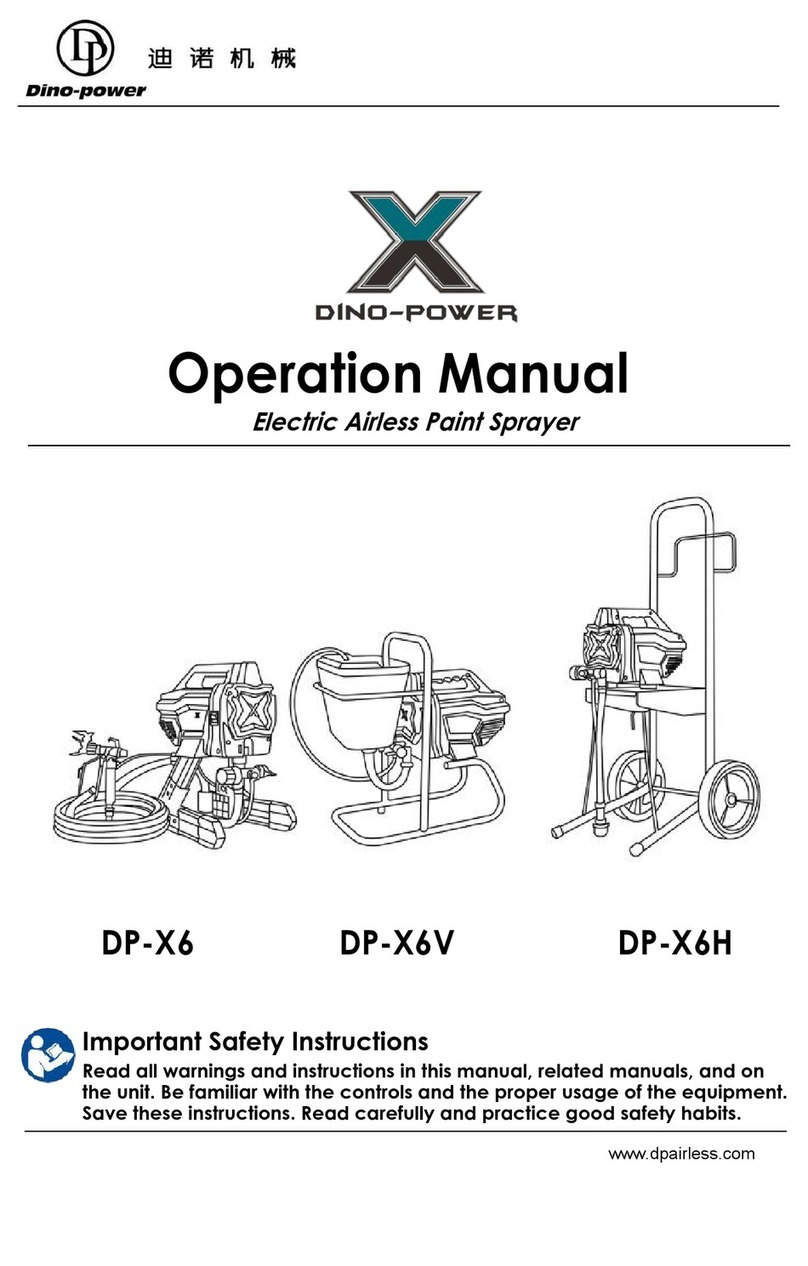
Dino-Power
Dino-Power DP-X6 User manual
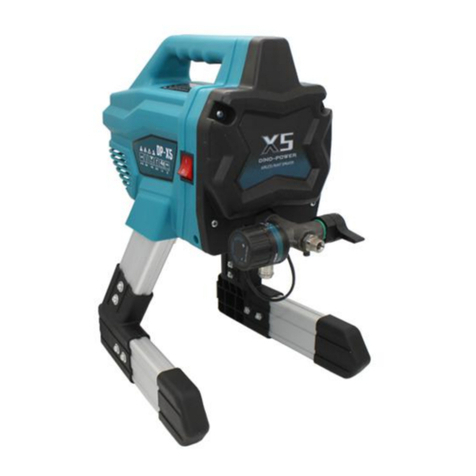
Dino-Power
Dino-Power DP-X5 User manual
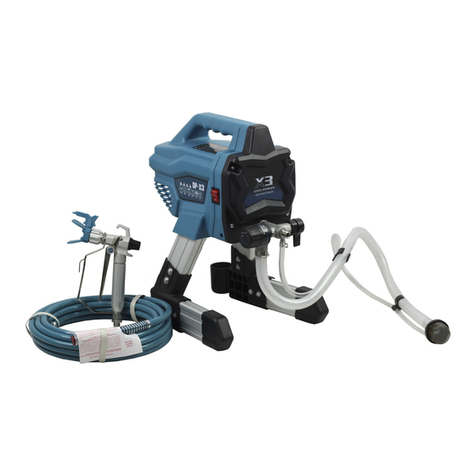
Dino-Power
Dino-Power DP-X3 User manual
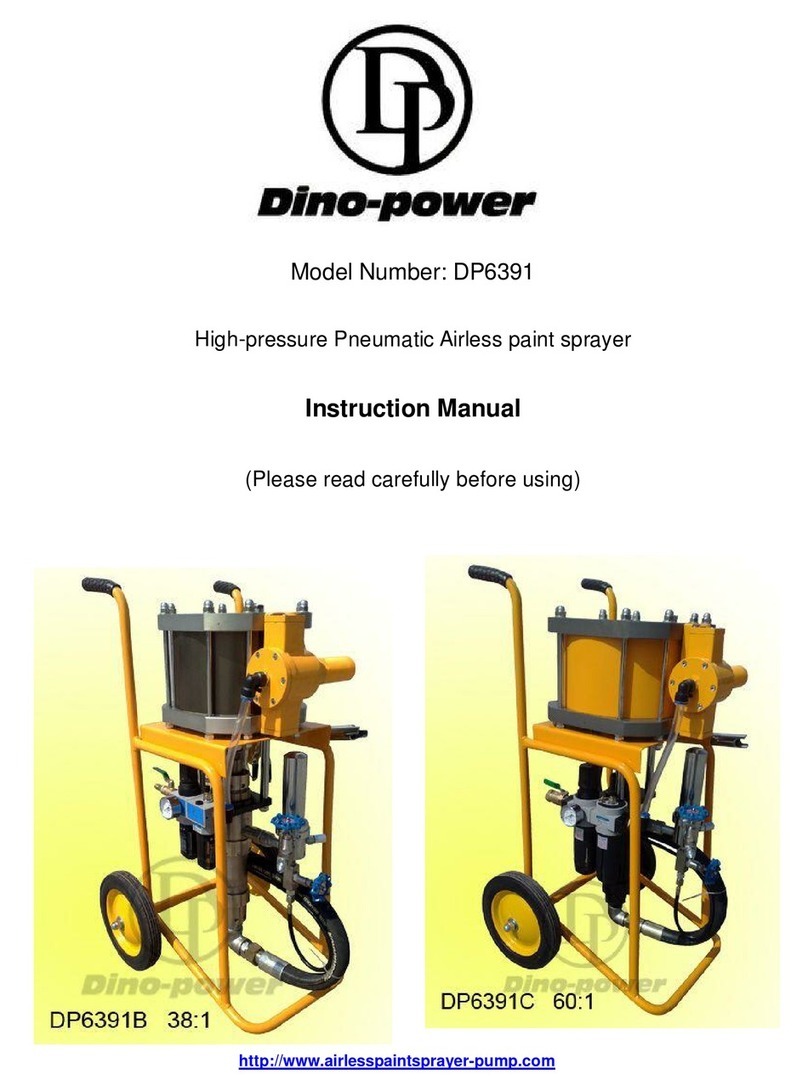
Dino-Power
Dino-Power DP6391C User manual
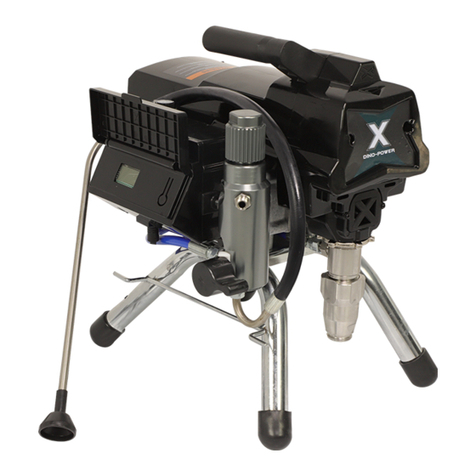
Dino-Power
Dino-Power DP-X Series User manual
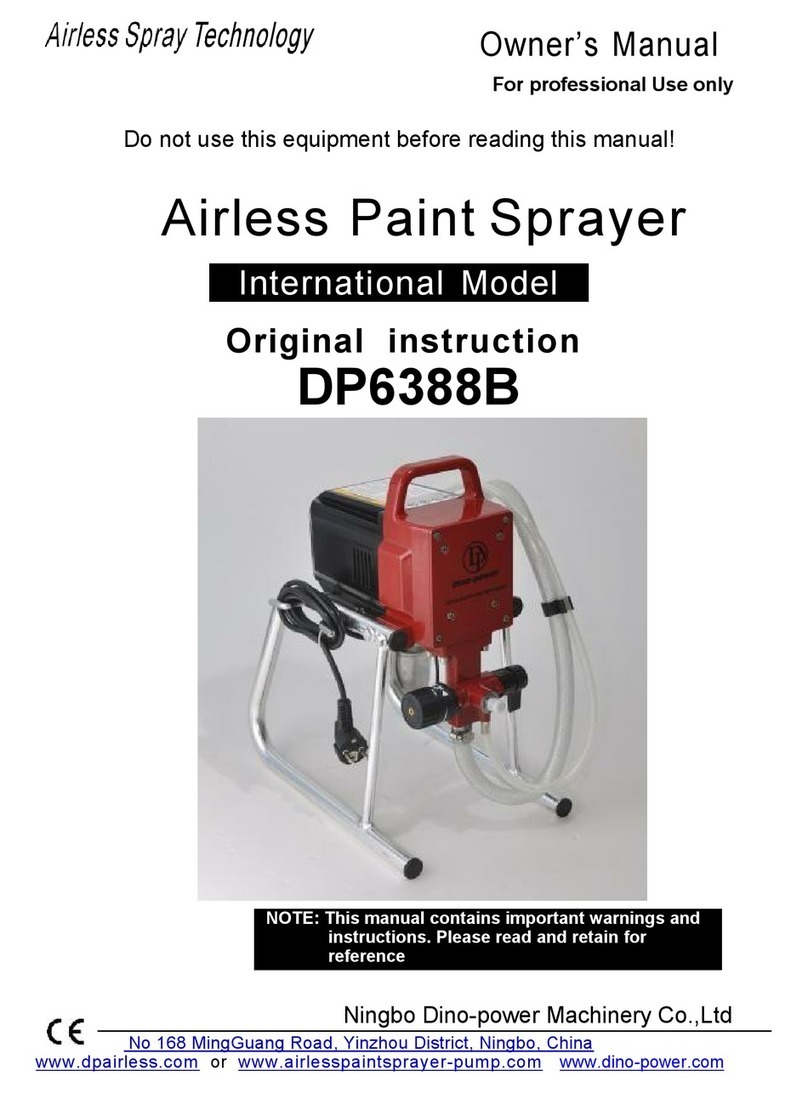
Dino-Power
Dino-Power DP6388B Operation instructions
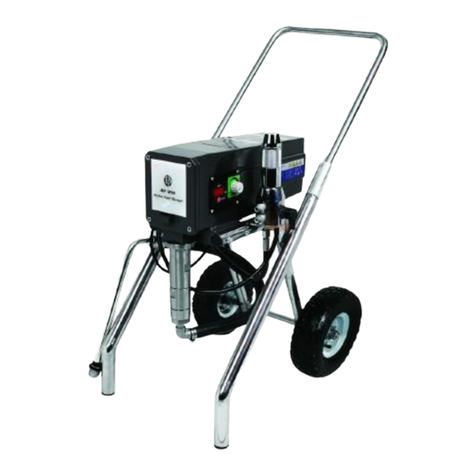
Dino-Power
Dino-Power DP-6840iB User manual
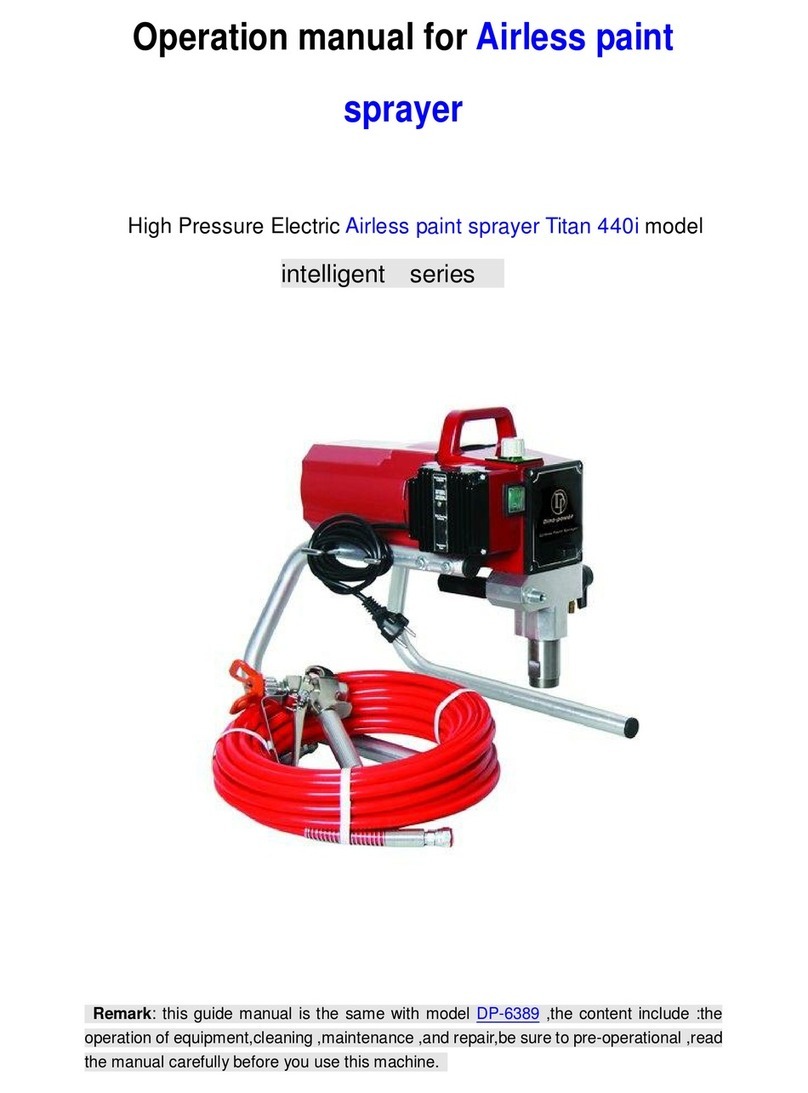
Dino-Power
Dino-Power Titan 440i User manual

Dino-Power
Dino-Power DP-X Series User manual

